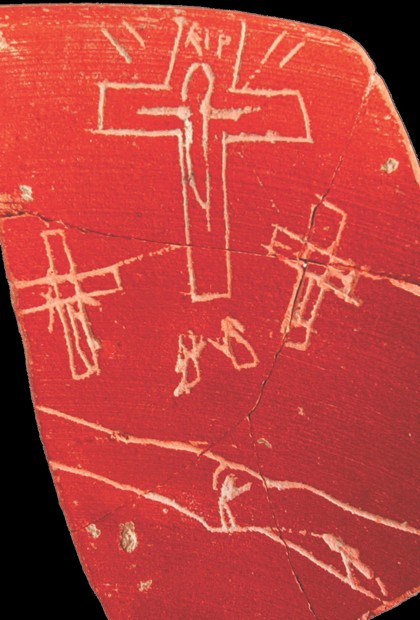
 |
Freethought & Rationalism ArchiveThe archives are read only. |
|
|||||||
|
|
Thread Tools | Search this Thread |
|
|
#11 |
|
Veteran Member
Join Date: Oct 2004
Location: Bordeaux France
Posts: 2,796
|
Is it possible to suppose that these pieces of pottery were made in Egypt during the 3rd century, imported later (when ?) to Iruña Veleia, and broken accidentally (when ?). Then the ostraca could be engraved with Christian scenes, or anything considered useful.
In Aquitaine (north of the Pyrenees) have been found many very old inscriptions containing names of gods or persons. These names can be interpreted as Basque names, except a few, which are ascribed to Iberian, as nobody understand these names ! |
|
|
|
|
#12 |
|
Contributor
Join Date: Mar 2003
Location: London UK
Posts: 16,024
|
Why is a depiction of three crosses assumed to be xian when googling three crosses immediately finds a site referring to three crosses in astrological thinking with a more important central cross?
http://www.alanoken.com/docs/3crosses.htm |
|
|
|
|
#13 |
|
Veteran Member
Join Date: Dec 2004
Location: San Juan, Puerto Rico
Posts: 7,984
|
Anything having to do with Basque antiquity is to be treated with utmost suspicion. Basque nationalist terrorism does not consist only of bombs and assassinations, but also of falsifying history.
|
|
|
|
|
#14 |
|
Veteran Member
Join Date: Nov 2007
Location: Chicago, IL
Posts: 3,058
|
|
|
|
|
|
#15 |
|
Veteran Member
Join Date: Dec 2004
Location: San Juan, Puerto Rico
Posts: 7,984
|
A brief research of Spanish web pages on the subject casts much doubt regarding the authenticity/interpretation of the findings. Example: The claimed 'basque' inscriptions would lead to the conclusion that said language has not changed in almost two thousand years, which is doubtful.
|
|
|
|
|
#16 | |
|
Veteran Member
Join Date: Apr 2004
Location: London, UK
Posts: 3,210
|
Quote:
I've re-uploaded it here. Hmmm. The closer you look at it the more hokey it gets. "Requiescat in Pace"??? That seems like a very Roman Catholic sort of phrase. Do you know when that phrase was in use? Was it current in the 3rd century? Regardless, you needn't have gotten so excited anyway Jeffrey, even if this were a valid find, it would only knock Pete's 4th century origins out the window, it wouldnt' touch mythicism in general because mythicism accepts that by the 3rd century probably a substantial proportion of Christians believed the gospel story. |
|
|
|
|
|
#17 |
|
Veteran Member
Join Date: Jan 2006
Location: London, Ontario, Canada
Posts: 1,719
|
RIP seems fairly clear:
 Not a slam-dunk, true. But it isn't INRI either. Couldn't have been, I'd say, as, if the dating is right, the Vulgate hadn't yet been written. If it is Roman letters, it seems to end in IP. If it's Greek, in IR. Beyond RIP, does either suggest anything? Is RIP an authentic Roman phrase, does anyone know? I'm asking because if it isn't there may be a dating problem. Gerard Stafleu |
|
|
|
|
#18 |
|
Veteran Member
Join Date: Dec 2004
Location: San Juan, Puerto Rico
Posts: 7,984
|
http://www.gara.net/paperezkoa/20080...ti-es-una-conv..
Spanish egiptologist, JUAN CARLOS MORENO, explains why at least some aspects of the find (the name Nefertiti in an inscription) are evidently fraudulent. That name is a modern European invention, and refers to a queen that would have been unknown in Roman times. |
|
|
|
|
#19 | ||
|
Veteran Member
Join Date: Nov 2007
Location: Chicago, IL
Posts: 3,058
|
Quote:
And if the ostraca is from a funeral/commemorative urn, then the inscription -- if it indeed is RIP -- is hardly out of place. Quote:
Jeffrey |
||
|
|
|
|
#20 |
|
Veteran Member
Join Date: Jun 2005
Location: Maryland
Posts: 1,402
|
All in all, looks pretty hokey to me. The urns and other shards may be actual 3rd c. stuff, but the scratches look decidedly childish and simplistic for such things.
|
|
|
| Thread Tools | Search this Thread |
|